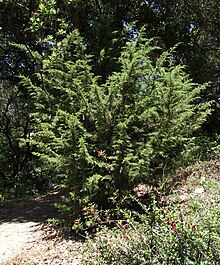Loading AI tools
Californian species of western cypress From Wikipedia, the free encyclopedia
Hesperocyparis goveniana commonly known as Californian cypress[4] and Gowen cypress,[5] is a species of western cypress that is endemic to a small area of coastal California near Monterey. It was formerly classified as Cupressus goveniana.
| Hesperocyparis goveniana | |
|---|---|
 | |
| Hesperocyparis goveniana at the UC Botanical Garden, Berkeley, California | |
| Scientific classification | |
| Kingdom: | Plantae |
| Clade: | Tracheophytes |
| Clade: | Gymnospermae |
| Division: | Pinophyta |
| Class: | Pinopsida |
| Order: | Cupressales |
| Family: | Cupressaceae |
| Genus: | Hesperocyparis |
| Species: | H. goveniana |
| Binomial name | |
| Hesperocyparis goveniana ((Gordon) Bartel | |
 | |
| Natural range of Hesperocyparis goveniana (sensu stricto) | |
| Synonyms[3] | |
|
List
| |
The tree is endemic to the Monterey Peninsula in coastal Monterey County, located on the Central Coast of California, in the Western United States.
The tree is found in small, scattered populations, and not in large forests of its species. Hesperocyparis goveniana occurs with Hesperocyparis macrocarpa (Monterey cypress), in the two groves where the Monterey cypress occurs naturally, in Monterey County.[6] Outside of California, Hesperocyparis goveniana has been introduced to Robinson Crusoe Island in Chile.[7]
It is on the IUCN Red List of endangered species.[1]
Hesperocyparis goveniana is an evergreen tree with a conic to ovoid-conic crown, very variable in size, with mature trees of under 1 m (3 ft 3 in) on some sites, to 50 m (160 ft) tall in ideal conditions.[8]
The foliage grows in dense sprays, dark green to somewhat yellow-green in color. The leaves are scale-like, 2–5 mm (0.08–0.20 in) long, and produced on rounded (not flattened) shoots.
The seed cones are globose to oblong, 11–22 mm (0.43–0.87 in) long, with 6 to 10 scales, green at first, maturing brown or gray-brown about 20–24 months after pollination. The cones remain closed for many years, only opening after the parent tree is killed in a wildfire, thereby allowing the seeds to colonize the bare ground exposed by the fire. The male cones are 3–5 mm (0.12–0.20 in) long, and release pollen in February/March.
Typically cones of H. goveniana are smaller than those of H. macrocarpa.
Hesperocyparis goveniana was first described and given the scientific name Cupressus goveniana by George Gordon in 1849.[3] It was described from a specimen grown in the gardens of the Royal Horticultural Society from seed collected by Karl Theodor Hartweg. It was named by Gordon for the then secretary of the society, James Robert Gowen.[9] In 2009 genetic research into the relationships of Cupressus and Juniperus lead to the reclassification of almost all the new world species into a new genus, Hesperocyparis by Jim A. Bartel.[3] This move has been disputed,[10] but as of 2024 Plants of the World Online (POWO),[3] World Flora Online (WFO),[11] and the USDA Natural Resources Conservation Service PLANTS database (PLANTS) all list Hesperocyparis goveniana as the correct name.[12]
The varieties or subspecies, formerly included under Cupressus goveniana include:
Seamless Wikipedia browsing. On steroids.
Every time you click a link to Wikipedia, Wiktionary or Wikiquote in your browser's search results, it will show the modern Wikiwand interface.
Wikiwand extension is a five stars, simple, with minimum permission required to keep your browsing private, safe and transparent.